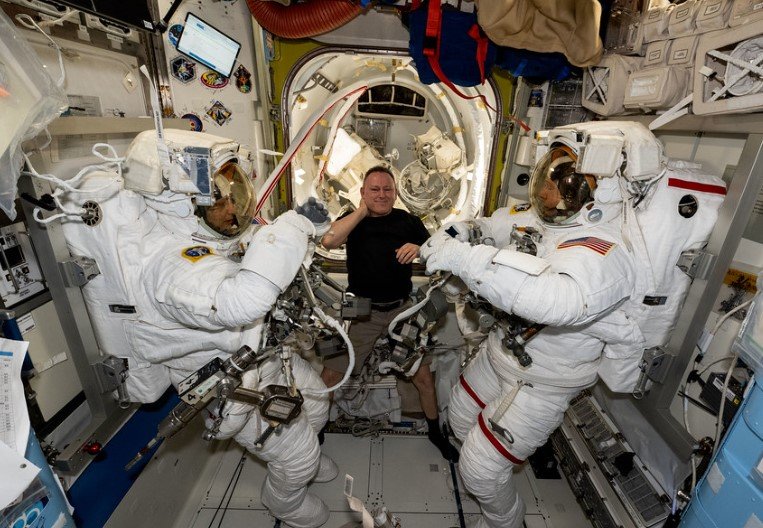Astronauts on the International Space Station during Expedition 73 are diving into key health studies to fight bone loss and understand brain changes caused by living in zero gravity. This work, happening in late August and early September 2025, aims to keep space travelers safe on long missions and could help treat health issues back on Earth.
Key Health Challenges in Space
Living without gravity takes a toll on the human body. Astronauts lose bone mass quickly, up to one to two percent each month, which raises risks of fractures and other problems when they return home.
This rapid loss happens because bones do not bear weight in space, much like what occurs in people with long bed rest on Earth. Brain changes also occur, affecting balance and how astronauts sense their surroundings. These shifts can make simple tasks tricky and impact safety during missions.
Recent studies show that after six months in space, some astronauts still have not fully regained bone density even a year later. This pushes researchers to find better ways to protect crews on trips to the Moon or Mars.
Bone Research Takes Center Stage
NASA astronaut Jonny Kim led efforts to grow bone stem cells in the station’s lab. This experiment looks at why bones weaken in space and tests ways to stop it.
By studying these cells, scientists hope to create treatments that keep bones strong during flights. The work builds on past findings that drugs like bisphosphonates, combined with exercise, can slow bone breakdown.
Exercise plays a big role too. Crew members use special machines to mimic weight-bearing activities, which help maintain muscle and bone health.
Here are some common exercises astronauts do daily:
- Treadmill runs with harnesses to simulate gravity.
- Weightlifting with resistance devices.
- Cycling on stationary bikes.
These routines, done for about two hours each day, fight muscle waste and support overall fitness.
Brain Adaptation Studies Advance
Cosmonaut Oleg Platonov used virtual reality tools to explore how the brain adjusts to weightlessness. This research focuses on balance, spatial skills, and how the brain handles motion without gravity’s pull.

Findings suggest that the brain rewires itself in space, which might explain dizziness or coordination issues upon return. Virtual reality tests help track these changes and could improve training for future explorers.
In one setup, astronauts wear headsets to simulate different environments, measuring how quickly they adapt. This data helps doctors predict and prevent problems on extended missions.
Other crew members, like Zena Cardman, joined in related tasks, such as scanning eyes with ultrasound to check for vision changes linked to brain fluid shifts.
Spacesuit Safety and Eye Health Checks
Safety gear got a close look as astronauts tested jetpacks on spacesuits. These devices could guide a drifting spacewalker back to the station if they float away.
Zena Cardman handled this in the airlock, also checking carbon dioxide removal systems. Such tests ensure suits work well for spacewalks, which are vital for station upkeep.
Eye health remains a focus too. Crews did ultrasound scans to monitor changes in the optic nerve and lens, often caused by fluid buildup in the head during spaceflight.
Doctors on the ground watched these scans in real time, spotting issues early. This ties into broader health monitoring, including heart scans and fitness tests.
| Health Area | Space Impact | Research Approach |
|---|---|---|
| Bone Density | Loss of 1-2% per month | Stem cell growth and drug tests |
| Brain Function | Balance and navigation shifts | Virtual reality simulations |
| Eye Health | Fluid pressure changes | Ultrasound imaging |
| Muscle Strength | Atrophy from no gravity | Daily exercise routines |
Preparing for Cargo and Future Journeys
The team also geared up for a Cygnus cargo ship launch, packing gear and setting up for new supplies. This resupply brings fresh experiments and tools to keep research going.
Commander Sergey Ryzhikov handled ventilation fixes and snapped photos of Earth landmarks, aiding studies on our planet from above. Other tasks included filming educational videos on space motion.
These efforts link to bigger goals, like NASA’s plans for Moon bases by 2030. Insights from Expedition 73 will shape health strategies for those trips.
Why This Matters for Earth and Beyond
Space research often leads to Earth benefits. Bone studies could help osteoporosis patients, while brain work might aid those with balance disorders.
As space travel grows, with private firms like SpaceX planning Mars trips, safeguarding health becomes key. Expedition 73’s work shows how teamwork between NASA and partners like Roscosmos drives progress.
What do you think about these space health breakthroughs? Share your thoughts in the comments and pass this article along to fellow space fans.
